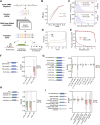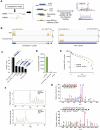Analysis of RNA translation with a deep learning architecture provides new insight into translation control
- PMID: 40219965
- PMCID: PMC11992669
- DOI: 10.1093/nar/gkaf277
Analysis of RNA translation with a deep learning architecture provides new insight into translation control
Abstract
Accurate annotation of coding regions in RNAs is essential for understanding gene translation. We developed a deep neural network to directly predict and analyze translation initiation and termination sites from RNA sequences. Trained with human transcripts, our model learned hidden rules of translation control and achieved a near perfect prediction of canonical translation sites across entire human transcriptome. Surprisingly, this model revealed a new role of codon usage in regulating translation termination, which was experimentally validated. We also identified thousands of new open reading frames in mRNAs or lncRNAs, some of which were confirmed experimentally. The model trained with human mRNAs achieved high prediction accuracy of canonical translation sites in all eukaryotes and good prediction in polycistronic transcripts from prokaryotes or RNA viruses, suggesting a high degree of conservation in translation control. Collectively, we present TranslationAI (https://www.biosino.org/TranslationAI/), a general and efficient deep learning model for RNA translation that generates new insights into the complexity of translation regulation.
© The Author(s) 2025. Published by Oxford University Press on behalf of Nucleic Acids Research.
Conflict of interest statement
None declared.
Figures





Update of
-
Analysis of RNA translation with a deep learning architecture provides new insight into translation control.bioRxiv [Preprint]. 2024 Jul 2:2023.07.08.548206. doi: 10.1101/2023.07.08.548206. bioRxiv. 2024. Update in: Nucleic Acids Res. 2025 Apr 10;53(7):gkaf277. doi: 10.1093/nar/gkaf277. PMID: 39005319 Free PMC article. Updated. Preprint.
Similar articles
-
Analysis of RNA translation with a deep learning architecture provides new insight into translation control.bioRxiv [Preprint]. 2024 Jul 2:2023.07.08.548206. doi: 10.1101/2023.07.08.548206. bioRxiv. 2024. Update in: Nucleic Acids Res. 2025 Apr 10;53(7):gkaf277. doi: 10.1093/nar/gkaf277. PMID: 39005319 Free PMC article. Updated. Preprint.
-
Global analysis of ribosome-associated noncoding RNAs unveils new modes of translational regulation.Proc Natl Acad Sci U S A. 2017 Nov 14;114(46):E10018-E10027. doi: 10.1073/pnas.1708433114. Epub 2017 Oct 30. Proc Natl Acad Sci U S A. 2017. PMID: 29087317 Free PMC article.
-
A deep recurrent neural network discovers complex biological rules to decipher RNA protein-coding potential.Nucleic Acids Res. 2018 Sep 19;46(16):8105-8113. doi: 10.1093/nar/gky567. Nucleic Acids Res. 2018. PMID: 29986088 Free PMC article.
-
Alternative translation start sites and hidden coding potential of eukaryotic mRNAs.Bioessays. 2008 Jul;30(7):683-91. doi: 10.1002/bies.20771. Bioessays. 2008. PMID: 18536038 Review.
-
Non-Canonical Translation Initiation Mechanisms Employed by Eukaryotic Viral mRNAs.Biochemistry (Mosc). 2021 Sep;86(9):1060-1094. doi: 10.1134/S0006297921090042. Biochemistry (Mosc). 2021. PMID: 34565312 Free PMC article. Review.
Cited by
-
Machine learning-augmented m6A-Seq analysis without a reference genome.Brief Bioinform. 2025 May 1;26(3):bbaf235. doi: 10.1093/bib/bbaf235. Brief Bioinform. 2025. PMID: 40415679 Free PMC article.
References
MeSH terms
Substances
Grants and funding
LinkOut - more resources
Full Text Sources
Other Literature Sources

